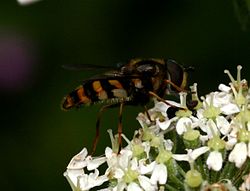| Megasyrphus erraticus | |
|---|---|
 | |
| Megasyrphus erraticus male | |
| Scientific classification | |
| Kingdom: | Animalia |
| Phylum: | Arthropoda |
| Class: | Insecta |
| Order: | Diptera |
| Family: | Syrphidae |
| Genus: | Megasyrphus |
| Species: | M. erraticus |
| Binomial name | |
| Megasyrphus erraticus | |
| Synonyms | |
Megasyrphus erraticus is a Holarctic species of hoverfly associated with mature conifer woodlands and plantations. [2]
